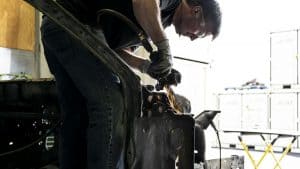Mig Welding & the Abrasives Industry

Welding is the process of melting and fusing two distinct parts together by applying heat to form a permanent bond. This process is the most common, economical, and efficient way to join metal. Once melted, a filler material is added to form a weld puddle that becomes a strong joint once cooled down. Abrasives serve an important purpose in the metalworking industry to remove the extra material, and smoothing out any inconsistencies.
What is MIG Welding?
Metal Inert Gas (MIG) welding, also known as Gas Metal ARC Welding (GMAW), is a welding process that fills the area where two metals are connected. In this instance, it uses a consumable wire that acts as both the electrode and the filler material. In comparison to TIG welding, MIG is much faster – and easier to learn.

The Advantages
High Welding Speeds
MIG is considered the faster method of welding, making it perfect for projects with high production rates. TIG welds are better for thinner metals and smaller projects due to their precise and clean welds.
For Veterans and Beginners
This welding process is clean and easy, and can be easy to learn. MIG is also referred to as the ‘hot glue gun’ of welding and is regarded as the easiest process to learn.
Low Hydrogen Process
The MIG wire process is recognized having very low hydrogen in the deposit, therefore doesn’t hold moisture like stick electrodes. This improves pre- and post-weld heat treatments in the long run.
The Disadvantages
Higher Setup Cost
While MIG welding can be more cost-effective in the long run, the equipment costs are going to be more expensive than the typical stick welding.
Stable Atmosphere Needed
The atmosphere surrounding the welding process has to be stable, limiting to dryer conditions. One of the most common MIG welding defects is porosity, gas becoming trapped in the weld metal. This showcases the importance of shielding gas coverage.
Markets & Key Abrasive Solutions
While MIG welding is common in most industries and manufacturers, some industries are more likely to use this form of welding. The following industries below are known to use this process the most due to the type of metal in the field.
- Automotive
- Construction
- High Production Manufacturing
If the metal consists of two pieces that will be joined, you may need to prep by using an abrasive product. It is necessary to remove any paint, rust, or other grime to ensure clean metal. Once a weld is finished, a post-processing step is required to help polish, cut, or shape to the desired effect. Learn more about ARC Abrasives’ family of products and how they can suit your needs.
Be sure to check out our social media pages on Linkedin and Facebook to keep up with our weekly updates!


